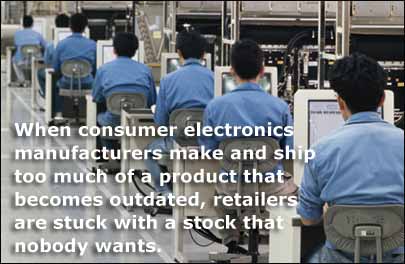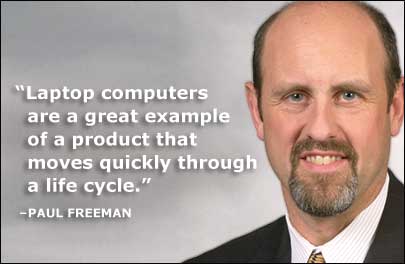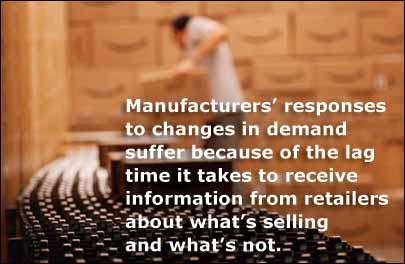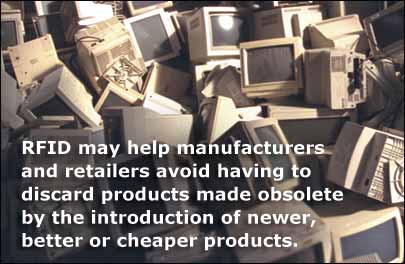Ever-changing customer tastes and rapidly advancing technologies make anticipating demand in the consumer electronics industry difficult. Take Sony’s NW-HD1 Network Walkman, which was introduced with great fanfare last year. Sony had to quickly drop its price on the Network Walkman by $50 to $349, because consumers objected to converting music into Sony’s proprietary ATRAC3 format instead of the ubiquitous MP3 files. The Network Walkman suffered further markdowns—to as low as $259—after Sony announced it was introducing a new version that would play music in both formats.
When consumer electronics manufacturers make and ship too much of a product that becomes outdated, retailers are stuck with stock that nobody wants. These items take up precious storage space in the back room. Retailers have to start slashing prices or return the obsolete merchandise to the manufacturers. Either way, profit margins for retailers and manufacturers take a hit.
RFID deployment in the consumer electronics industry could help retailers identify hot-selling items more quickly and make sure they have the items on store shelves when prices are high. It could also reduce the amount of space in the storeroom taken up by goods that might become obsolete if they fail to sell quickly. And RFID could help manufacturers better meet demand by tying production to real-time sales data. In fact, many analysts believe that this is one of the few sectors where both manufacturers and retailers may benefit from RFID.
For now, retailers are in the driver’s seat. Some have already shifted the burden of storing merchandise to manufacturers, and now they are asking them to shoulder the costs of RFID tagging as well. “Retailers are increasingly focusing on having manufacturers manage parts of the supply chain,” says Chris Remy, senior manager of Accenture’s supply chain service. “They would rather have consumer electronics companies hold on to the products and be able to respond when the product is selling or, in the case of product obsolescence, take the product back.”
Some consumer electronics manufacturers—such as Hewlett-Packard, Microsoft, Panasonic and Sony—have begun tagging pallets and cases to meet the RFID mandates issued by mass merchandise retailers. And Best Buy, the Minneapolis-based consumer electronics chain, announced last August that it would require its major suppliers to begin applying RFID tags to pallets and cases by January 2006. The consumer electronics powerhouse will require major suppliers to tag all pallets and cases by May 2007. Late this summer, Best Buy also expects to issue item-level specifications for suppliers. (To learn more about Best Buy’s plans, see Best Buy Aims for Item-Level Tagging.)
Other major retail chains, besides Best Buy, are likely to spur adoption of RFID in the consumer electronics supply chain. But there are logistical challenges. Some 20 million digital TVs, 22 million DVD players and 22 million desktop and laptop computers will be shipped to U.S. retail stores alone in 2005, according to the Consumer Electronics Association (CEA), which represents U.S. manufacturers and retailers. Many retailers also stock some of the 667 million CDs and 1.5 billion DVDs that the Digital Entertainment Group estimates are sold each year. Still, the benefits could be huge. RFID tagging in the supply chain has the potential to bring up to $4 billion in annual savings to the $125 billion-a-year consumer electronics industry, according to a recent Accenture study.
And RFID may be well suited to this high-end industry. RFID tags—which can range from 25 cents to $1 or more—can be cost-effective on a $2,000 high-definition TV, a $35 printer ink cartridge that often gets miscounted during shipping and even an $11.99 CD, a commonly stolen item. Also, consumer electronics have historically short life spans due to technological innovation. “Laptop computers are a great example of a product that moves quickly through a life cycle,” says Paul Freeman, RFID program director at Best Buy. “It’s very different from paper towels or paper products. You could inventory those for a year if you wanted, and they’re not going to be replaced with something newer or better.”
Benefits for Retailers
RFID could help consumer electronics retailers address some of the industry’s most trying problems, including shrinkage and inventory control and management. “It’s clearly a system that can help retailers and the industry alike make better business decisions,” says Steve Koenig, senior manager of industry analysis for the CEA. “RFID makes it easy to know what inventory you have in your store, what’s in transit and where it is.”
Early last year, consulting firm Accenture convened the Electronics Industry RFID Workgroup, made up of manufacturers, retailers and technology suppliers in the consumer electronics industry, to study the application of RFID technology to the industry’s supply chain. The panel’s 12 members, who included representatives from Best Buy, Celestica, Dell, Microsoft and Texas Instruments, examined the benefits and problems of tagging pallets, cases and individual items.
The group found that the real value in consumer electronics would be item-level tagging. Say, for example, a customer wants to buy a specific item, and it’s not on the store shelf. If each item has an RFID tag and stores are wired with readers and antennas, then computers, digital cameras or printer cartridges could be tracked easily in the store or in the supply chain. The aim is to make the sale before customers leave the store. With RFID, store managers could have access to inventory data on handheld PDAs and could replenish stock as it gets depleted, says Lyle Ginsburg, who headed the panel and is Accenture’s managing partner for technology innovation within its products operating group.
But Best Buy believes that even at the pallet and case level, RFID will enable the company to capture data automatically and better track inventory from the manufacturing plant to its distribution centers, warehouses and stores. The company currently uses bar code technology to track inventory. RFID will improve the accuracy of that information and automate data collection. “We can’t afford to collect the data,” says Best Buy’s Freeman. “The amount of product, speed at which it moves and the number of locations limit bar code use.”
Industry experts also say that RFID could help retailers reduce theft. Consumer electronics retailers could deter thieves by deploying RFID readers, which would set off alarms when installed at store doors and would detect counterfeit returns by the absence of manufacturers’ RFID tags or unique identification numbers.
Benefits for Manufacturers
Many consumer electronics manufacturers suffer from a lack of flexibility in production cycles, because they’ve outsourced their manufacturing to subsidiaries or other companies in lower-cost areas of the world, such as Asia. Often manufacturers need to coordinate with many different companies to respond effectively to demands.
Manufacturers’ response times also suffer because of the lag time it takes to receive information about what’s selling and what’s not. Typically, they receive point-of-sale data from retailers after a product with a stock-keeping unit is scanned on its way out of the store. Often the data is a week old before the manufacturer receives it.
Accenture’s Remy says that there is limited benefit for suppliers to have just pallets and cases tagged. The benefit comes from tagging the individual item, and some consumer electronics manufacturers are already doing that with large products, such as computer printers or TVs.
The promise of RFID is that when each item is tagged, the retailer will be able to communicate precisely which cell phone model, in which color faceplate, is selling at which store. “If they see that yellow sells really well but the red ones are not moving, they can make decisions in terms of allocation and planning,” Best Buy’s Freeman says of the information his company plans on sharing with manufacturers. The manufacturers can save time and resources by speeding up production of yellow items and slowing production of red.
HP is one supplier that expects to reap the benefits. This year, HP plans to tag about 2 percent of its shipments—or 1 million of its 53 million consumer product units. HP’s All-in-One printers, Presario desktop PCs, notebook computers, LaserJet and DeskJet printers, and Photosmart printer models are being tagged at pallet and item levels; shipments of iPaq Pocket PCs are being tagged at pallet and case levels, with several iPaqs in each case. The company has been tagging shipments of 40 products to Wal-Mart since January and expects to tag all 65 product lines it ships to the retail giant by year’s end.
HP is also deploying RFID in its internal supply chain—it has implemented RFID at 26 manufacturing sites worldwide. The company expects the technology will help make HP more efficient, more adaptive to change and better able to respond to spikes in demand. Salil Pradhan, chief technologist for HP’s RFID program, says the company’s plan is to save 10 percent in terms of labor, inventory and other costs. At HP’s printer facility in Memphis, RFID has helped the company improve the time it takes to build each pallet from 90 seconds to 11 seconds. At the company’s inkjet cartridge plant in Chester, Va., RFID has given HP greater accuracy in counting the inkjet cassettes as they are being transferred from the factory to the distribution center.
Pradhan says HP gets some sales data from retailers today, but the amount does not approach the wealth of information he expects to receive from Wal-Mart and other retailers once all tagged pallets and cases are read as they move through portals at distribution centers, warehouses and stores. This data is critical in a business in which products have a short shelf life. “If I have something in my supply chain and it sits in a warehouse for a month, it can become obsolete,” says Pradhan. “Knowing where inventory is is absolutely critical for a consumer electronics supply chain.”
The Business Case for RFID
While the business case has yet to be proved, the Electronics Industry RFID Workgroup concluded that RFID’s benefits to the industry could translate into billions of dollars in value over the coming years—and that those benefits would be shared by retailers and manufacturers. The group calculated the net present value (NPV) for a $10 billion manufacturer to be just under $300 million for a full-scale investment in RFID technology. For a $10 billion retailer, the NPV was also calculated at just under $300 million for a full-scale RFID investment.
In addition to reducing out-of-stocks and enabling better inventory management, RFID could be used to validate warranty claims. One danger of outsourcing functions to partners in Asia and elsewhere is that counterfeit warranties might be peddled on the gray market and the manufacturer would still be required to maintain liability. With RFID, each warranty could be managed more easily because the history of the product could be associated with the tag’s unique serial number in a database.
RFID could offfer customer-service benefits as well. “The post-sales service equation is both a great opportunity and a big problem,” says Accenture’s Ginsburg. After a sale, the warranty form might be filled out incompletely or it might end up in the garbage. With RFID, retailers could capture the information up front when a person checks out—providing the customer agrees, of course—and the product’s unique serial number could be validated.
Not all consumer electronics manufacturers or retailers believe that the return on investment from a conversion to RFID will be worth the cost of implementation. An IT official at one manufacturing company that has met Wal-Mart’s mandate and will also have to comply with the requirements issued by Target and Best Buy grumbled that the company sees little benefit in the conversion to RFID. He said tagging items is merely costing his company money, with no potential gains in sight.
In a white paper on RFID, Dell said that for most cost-benefit situations, the technology “falls into the category of hold” at Dell. “Since Dell has already invested billions of dollars to develop business processes that are state-of-the-art, it is often hard to find overwhelming savings from auto-ID that justifies immediate implementation,” writes Mark Dinning, who is in Dell’s supply chain engineering group.
Dinning points out that this equation could change in a relatively short period of time as the costs of implementing the technology decrease. Dell is in a unique position because it sells direct to its customers, not through retailers. If and when the company does consider adopting RFID technology, it may look first at implementing the technology “upstream” to get its suppliers to start tagging their shipments to Dell.
Not all consumer electronics retailers have joined Best Buy on the RFID bandwagon, either. Circuit City, based in Richmond, Va., is taking a wait-and-see attitude. Mike Jones, Circuit City’s chief information officer, says his company will sit on the sidelines until RFID standards are ironed out, read rates of products encased in metal improve and the cost of implementation drops. He says Circuit City has other IT projects that are taking priority, including replacing aging hardware and software in the company’s 627 retail stores and improving enterprise data management.
Circuit City may test RFID in the next year or so, but Jones sees no benefits in being an early adopter. “Go back and tell me who was the first bank to offer the ATM or who was the first service station to offer pay-at-the-pump service,” Jones says. “Both of those are prevalent today wherever you go. But no one remembers who the first mover was.”
Overcoming Obstacles
Item-level tagging could improve customer service, but it also raises privacy concerns about information that might be gathered from the tags without the shopper’s knowledge. Best Buy has set up a group to study the issue and come up with an RFID privacy policy. “The privacy of our customers is a top priority,” says Best Buy’s spokeswoman Dawn Bryant. “We’re only in the infancy stages of case and pallet tagging and have not implemented any RFID-specific policies yet because it’s too early in the process.”
Another complication is that many consumer electronics products are encased in metal or contain liquids, both of which interfere with the ability to read RFID tags. HP did aggressive testing and learned valuable lessons about the placement of tags on cases or items encased in metal and those containing liquids, such as printer ink cartridges. HP also found that testing RFID in a live manufacturing environment was important to achieving high read rates, because RF reflections, absorptions and other interference in a manufacturing plant cannot be duplicated precisely in the lab. HP claims that with certain product lines, it is now able to read the tags 99 percent of the time because of the intelligent placement of the tags on those products. This research has been passed on to all of HP’s targeted manufacturing facilities around the world.
Some analysts believe that Best Buy’s tagging announcement will be more palatable to suppliers than similar mandates from Wal-Mart, Target and Tesco. “I see it having better acceptance among the suppliers,” says Kara Romanow, research director at business consultancy AMR Research. “It has all of the benefits that Wal-Mart talked about—helping with out-of-stock replenishments, tracking products in the supply chain—except the cost model works, which means you can have the support of your suppliers.”
While consumer electronics manufacturers will have to tag pallets and cases to meet retailers’ mandates, the question remains: When will they embrace RFID and deploy the technology to achieve efficiencies in their internal supply chains? Accenture’s Remy says that it may take a few years before the companies fully implement RFID throughout their organizations and are able to realize the benefits. “The technology out there is getting better, and suppliers and manufacturers are getting a lot more test cases,” he says. “People are now in a wait-and-see mode.”





